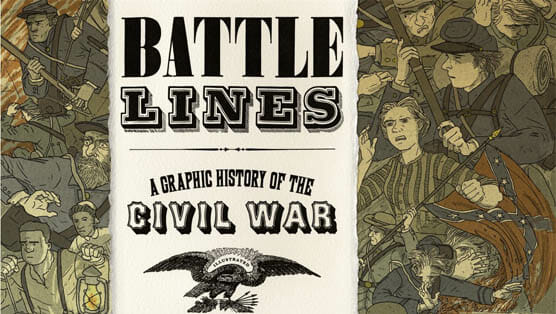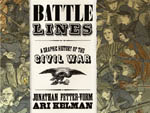Battle Lines: A Graphic History of the Civil War by Jonathan Fetter-Vorm and Ari Kelman
Comics Reviews
Writer: Jonathan Fetter-Vorm and Ari Kelman
Artist: Jonathan Fetter-Vorm
Publisher: Hill & Wang
Release Date: May 5, 2015
Using 15 different objects to provide inspiration for graphic stories that average 10 to 20 pages, Battle Lines is a new approach to a subject that has been covered extensively. Jonathan Fetter-Vorm, a writer and illustrator, and Ari Kelman, a historian, teamed up to produce a book that, while not comprehensive in its approach, serves as a smart way to illuminate some lesser-known aspects of the war.
 Each story opens with the front page of a newspaper (drawn, not photographed), as a way to introduce key themes and tie the tales together, looking back to the previous story as much as the next. The combination of hand-drawn headlines and typeset body text is a bit awkward to the eye, but the audience for this book is not primarily comic fans. Instead, one can see the people’s approach behind Battle Lines being used in a high school history class.
Each story opens with the front page of a newspaper (drawn, not photographed), as a way to introduce key themes and tie the tales together, looking back to the previous story as much as the next. The combination of hand-drawn headlines and typeset body text is a bit awkward to the eye, but the audience for this book is not primarily comic fans. Instead, one can see the people’s approach behind Battle Lines being used in a high school history class.
Some stories have greater impact than others. “Chapter 2: A Writ” may be necessary to setting the stage as it discusses various pieces of legislation that contributed to the outbreak of war, but its visual metaphor of the laws as a teetering tower of stone balanced on two small blocks (“slavery” and “liberty”) that cannot possibly hold them is fairly corny. On the other hand, “Chapter 11: Death Letter” (the longest story in the book) uses the comics form effectively, playing words and images against one another to produce a sense of mournfulness in the reader. In general, when the characters are given time to develop, the book is better. Fetter-Vorm’s sketchlike style works well when it has to convey the energy of battle or riot, and less well when it has to shoehorn in a bunch of words.
“Chapter 8: A Photograph” and “Chapter 9: Draft Numbers” are well paced and use structure to their advantage. The former sets up its pages in a nine-panel grid, each panel resembling the horizontal of the photograph in question, the parallel drawn through having the photographer form a frame with his hands as he looks for the right image. Broken up by a two-page spread of a single panel that conveys the scope of the aftermath of Gettysburg rather than its details, it’s a finely rendered story that raises questions intelligently, without outlining them in neon lights. “Draft Numbers” focuses on the fact that the well-to-do could buy their way out of conscription by telling three parallel tales in pages that feature three parallel panels, initially rendered in separate colors, then with the palette bleeding over as the stories intersect. When the images get to do the heavy lifting and the words are minimized, the book transcends feeling purely educational and can even be moving.